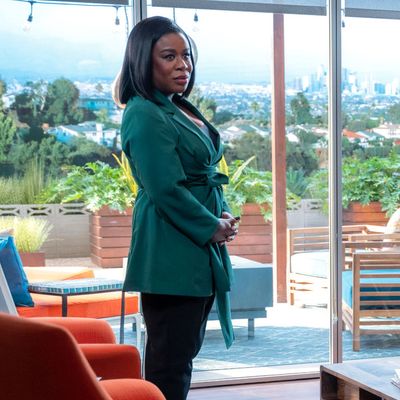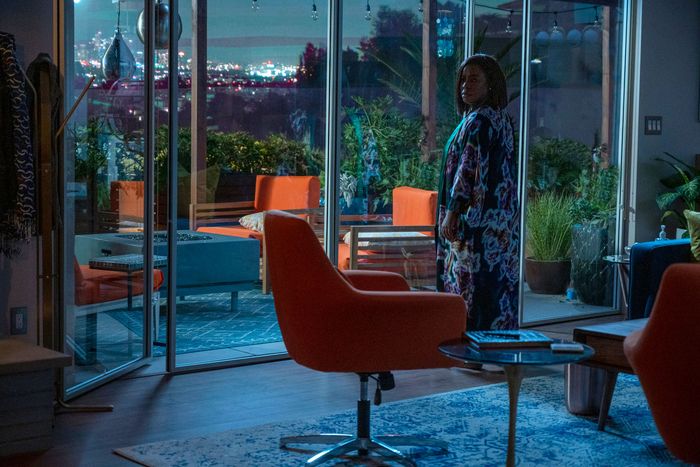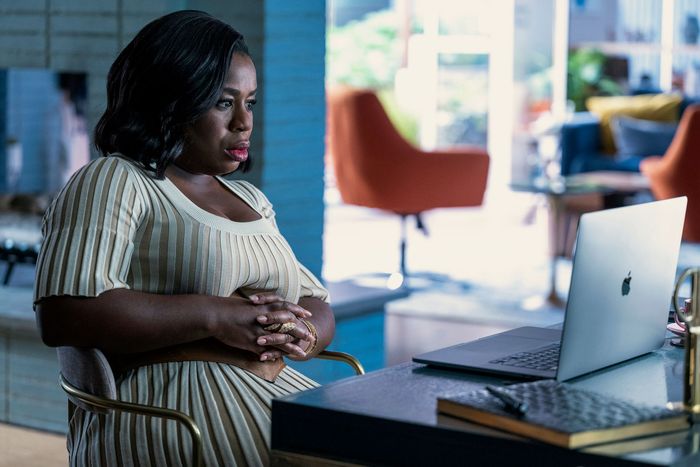
If you’re not already intrigued by the psychological drama on display in HBO’s revival of In Treatment, you may find yourself ensorcelled by its setting: the Architectural Digest–worthy home of Uzo Aduba’s therapist Dr. Brooke Taylor. It’s a cliché to say that the setting of any show is really a character within it, but the house does do the job of acting as a stand-in for her character’s father, a Los Angeles architect who designed it and who, as we learn as the season goes on, had a fraught relationship with Brooke.
Though you might be struck by the urge to see the house in real life, or at least look it up on Zillow, the rooms were all designed for the show: The house’s interiors were built on a soundstage, with the exteriors filmed on location. However, that enviable view of downtown Los Angeles outside Brooke’s window? It’s real — sort of. “It may have taken longer to find that view than to find the house,” production designer Catherine Smith says, describing how In Treatment’s team searched for just the right view from Baldwin Hills across Los Angeles. “It was 24 hours [of footage]. What you get with an actual video is movement — the twinkling of the lights, the wind blowing a bit of greenery, or an airplane going by.”
Since so much of In Treatment takes place in that one set, with a few Zoom calls out to Brooke’s patient Eladio, played by Anthony Ramos, the show’s designers spent a lot of time planning out the revival’s office space and considering how Brooke might dress herself to meet her patients. With the second batch of episodes airing this weekend, Smith and costume designer Tiffany Hasbourne walked us through the design thinking behind Brooke’s carefully composed, and very colorful, practice.
The architecture
When the writers put together their vision for Brooke’s character, according to Smith, they were already intent on the idea that she would be temporarily conducting her therapy sessions during COVID in her mid-century-modern home in Baldwin Hills, one of the wealthiest Black neighborhoods in the country. From there, the production designer worked with a location scout to find a home to use for the exterior shots — not necessarily in the neighborhood, though in this case, it was. The plot point that Brooke’s father is supposed to be a successful Black architect also complicated the search. “I needed a house that looked like an architect made it, but you can’t use something that people would recognize as somebody else’s home,” Smith says. The location they settled on worked because it could seem both well designed and anonymous.
As a model for what Brooke’s father’s designs might look like, Smith thought of Paul Williams, whose work shaped many homes throughout Los Angeles. “He’s known more for a Hollywood Regency style, but his firm had a lot of architects who did some amazing mid-century buildings,” Smith says. “So that’s where I was thinking, but there are so many great mid-century architects in Los Angeles. I stole from all of them liberally.”
In designing the set for the home’s interiors, she decided to build it in the form of many of L.A.’s ranch-style homes, with the view through Brooke’s windows being central to the design. “I wanted to have a wall that would be all windows,” she says, “which I figured would be easy to film but would also allow a free flow of air for COVID. The idea is that she had this house, it was built at a certain time and then she renovated certain details of it, like the kitchen and the sliding glass doors.”
The furniture
Another part of the design logic for Brooke’s home came out of wanting to establish a distinction between her personality and Paul Weston’s (Paul is the therapist played by Gabriel Byrne who anchored the previous seasons of In Treatment). “That set was very detailed and very cluttered and layered, and this is the antithesis of that,” says Smith, who worked as an art director on several episodes of the original run. “Unlike Paul, her place is a reflection of who she wants to be. Paul’s place is incidental.”
The dynamics of aspiration and power play into the furniture too. Most of the therapy sessions take place with the client sitting on her blue couch and Brooke seated across from — and also above — them in an orange chair. “You want her to look great in that chair, like a really good outfit,” Smith says. As it happened, working with set decorator Jon Bush, the In Treatment design team settled on the color orange first and then ended up reupholstering a chair from Design Within Reach with the new shade of fabric. “We tried a bunch of different colors, but orange was the universal first choice of everyone,” Smith says.
For the couch, Smith considered yellow or orange as well but settled on blue. “I liked the use of colors with this particular house and this particular character,” Smith says. “We ended up trying to figure out in which room the blue couch looked good and which room the yellow couch looked good. I thought the yellow couch would look good in the living room [where Brooke does most of her sessions], but then, of course, I was wrong.”
The tchotchkes
Even while working from her home, Brooke is pretty protective of what she lets her patients see, which means that the set dressing around her all had to seem intentional. “This person’s personality was such that it was so controlled, there was less clutter,” Smith says. Among what we can see are some of Brooke’s childhood photos (which are Aduba’s own) as well as paintings by Norman Lewis, a Black Abstract Expressionist, which were cleared through his estate. In terms of Brooke’s books, Smith gave the writers a questionnaire about what Brooke’s taste might be. Based off that, she included works by Roberto Bolaño, whom Brooke discusses in sessions with Ramos; psychology journals that she might be reading; and books by Ta-Nehisi Coates, a suggestion from the writers.
Also crucial to understanding Brooke’s personality: her very fancy espresso machine, also suggested by the writers. “They had this whole idea that she would be a coffee person who has the perfect way to make a cup of coffee,” Smith recalls. “They were very intent on her having a coffee ritual.”
The wave machine
Among the pieces on display in Brooke’s home, one stands out in particular: a wave machine that also appears in the credits, though this time its color is orange tinted rather than the blue-tinted credits sequence of the original run. “The writers felt very strongly about bringing that back,” Smith says. “The idea is that it is an artifact of where they both were together.” On the plaque, there is a reference to an institute both Brooke and Paul had attended, where they previously crossed paths, and Smith even tracked down the original vendor of the machine, Hughes Wave Motion Machines, so that it would match Paul’s.
The wardrobe
Going into In Treatment, costume designer Tiffany Hasbourne was familiar with the ways that TV therapist characters, who are all too often Black women, are dressed in generic professional clothes. “That is why I wanted everything to be intentional,” Hasbourne says. “Instead of her grabbing a regular Ann Taylor suit, she gets custom, colored suits.” Brooke doesn’t often wear identifiable designers because Hasbourne wanted to place her in custom looks to emphasize her wealth and confidence, but she based her style influences on the character’s specific cultural context. “With her being located in the Ladera Heights–Baldwin Hills area, we started to put look books together,” Hasbourne says. Later on in the series, you can also see Brooke toting a trendy Telfar bag “because that’s what the women in that area would wear.”
One specific design that Hasbourne felt epitomized her approach to Brooke’s costume is the cream dress she wears with a big corseted belt, as seen in the new season’s posters: “It helped show the power of who she was at her core.”
Elsewhere, the urge to emphasize Brooke’s power came out in her wardrobe’s embrace of color. Hasbourne dressed Aduba in numerous monochrome outfits — which, she points out, ended up anticipating the colors on display at the inauguration — as a way to project her character’s confidence. She hadn’t seen Smith’s ideas for Brooke’s furniture before she started working on the costumes, but their parallel thinking about Brooke’s love of color ended up meshing into a vision of a woman who asserts herself through both her clothes and her décor. “It just happened to work out that her office and her house were really colorful, and it made sense that her wardrobe would be,” Hasbourne says. “And it was big for us to see a woman who isn’t the normal sample size embrace color in her wardrobe.”
Brooke dresses differently depending on which patient she is seeing. “When she’s dealing with the men, we made sure to keep it very classy and strong, which is why when you see her with the men, oftentimes she’s in pants,” Hasbourne says. “Then when she is with women, she tends to be a little bit more feminine.” In one scene with Ramos’s Eladio, for instance, she dresses in a hot-pink power suit because Hasbourne felt it was “important for us to establish her as a powerful woman but still in touch with her femininity.”
The jewelry
Like her house, much of the jewelry Brooke wears is implied to be inherited, a way to show her own family history. Some of it is designed by Nigerian designers as a nod to Aduba’s own heritage. Other pieces are sourced from everywhere from Nordstrom to Neiman Marcus. “I thought about my own mother. One of my things as a kid was being able to go through my mother’s jewelry boxes,” Hasbourne says. “Whatever Brooke has not inherited, she is intentionally buying to leave as part of her legacy.”
The pajamas
The jewelry Brooke wears, like the fact that her clothes are custom, speaks to both her wealth and, crucially, the fact that she grew up with money. “She has class. She’s used to the finer things in life; she doesn’t know anything different,” as Hasbourne puts it. Brooke’s exterior is never not put together. Even when we see her late at night in emotional distress, she still wears a beautiful custom kimono. “I thought of the women in my life who are wealthy and what they wear in their leisure time,” Hasbourne says. “I wanted the audience to know that this is a woman who knows exactly who she is. We thought about it all, down to the slippers on her feet. And if she chooses to be barefoot, there’s a slipper close by, so in case someone shows up to her house, she’s able to put them on.”





